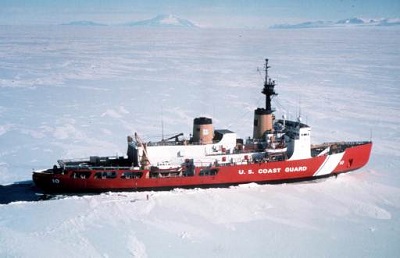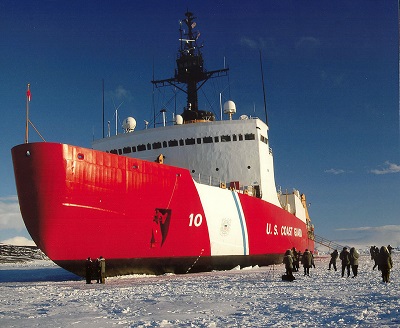Polar Star: 40 Years of Service
The U.S. Coast Guard heavy icebreaker Polar Star celebrates its 40th year of commissioned service this year.
Commissioned in 1976, the ship was built by Lockheed Shipbuilding and Construction Company of Seattle, Washington along with her sister ship, Polar Sea.
 Along with sister ship Polar Sea, Polar Star is one of the largest ships in the U.S. Coast Guard and the world's most powerful non-nuclear ships. She has the capability to break through ice up to six feet thick at a speed of three knots.
Along with sister ship Polar Sea, Polar Star is one of the largest ships in the U.S. Coast Guard and the world's most powerful non-nuclear ships. She has the capability to break through ice up to six feet thick at a speed of three knots.
The vessel’s three shafts are turned by either a diesel-electric or gas turbine power plant. Each shaft is connected to a 16-foot (4.9-meter) diameter, four-bladed, controllable-pitch propeller. The diesel-electric plant can produce 18,000 shaft horsepower (13,425 kilowatts) and the gas turbine plant a total of 75,000shaft horsepower (55,925 kilowatts).
The portion of the hull designed to break ice is 1.75 inches (44mm) thick in the bow and stern sections, and 1.25 inches (32mm) thick amidships. The hull strength is produced almost entirely from the massive internal support structure.
At one point, an installed heeling system could rock the ship to prevent getting stuck in the ice. The system consisted of three pairs of connected tanks on opposite sides of the ship. Pumps transferred a tank's contents of 35,000 gallons (133 cubic meters) to an opposing tank in 50 seconds and generate 24,000 foot-tons (65 MN·m) of torque on the ship. This system has now been removed due to maintenance issues.
Polar Star carries two helicopters during major deployments. They support scientific parties, do ice reconnaissance, cargo transfer, and search and rescue as required.
 The vessel has a variety of missions while operating in polar regions. During Antarctic deployments, her primary missions include breaking a channel through the sea ice to resupply the McMurdo Research Station in the Ross Sea. Resupply ships use the channel to bring food, fuel, and other goods to make it through another winter.
The vessel has a variety of missions while operating in polar regions. During Antarctic deployments, her primary missions include breaking a channel through the sea ice to resupply the McMurdo Research Station in the Ross Sea. Resupply ships use the channel to bring food, fuel, and other goods to make it through another winter.
In addition, to these duties, Polar Star serves as a scientific research platform with five laboratories and accommodations for around 20 scientists. The "J"-shaped cranes and work areas near the stern and port side of ship give scientists the capability to do at-sea studies in the fields of geology, vulcanology, oceanography, sea-ice physics and other disciplines.
In June 2006, the Polar Star went into a special status "Caretaker". This caretaker status required the crew to be reduced to 34 and to keep the ship ready for its return to the ice. However, Polar Star was refurbished at an estimated cost of $57 million and re-entered service in December 2012 for an intended period of seven to 10 years.
In February 2015, Polar Star was involved in the rescue of the Australian fishing vessel Antarctic Chieftain, towing her and her 27 crew to safety through ocean ice and snow nearly 20 feet deep in the Southern Ocean.
Now, well beyond her originally intended 30-year service life, Polar Star is participating in Operation Deep Freeze 2016 in the Southern Ocean. The mission to resupply the National Science Foundation’s McMurdo Station, Antarctica, is one of the most difficult U.S. military peacetime missions due to the harsh environment.
General characteristics
Type: Icebreaker
Displacement: 10,863 long tons (11,037 t) (standard), 13,623 long tons (13,842 t) (full)
Length: 399 ft (122m)
Beam: 83 ft 6 in (25.45m)
Height: 137 ft 10 in (42m) (from waterline)
Draft: 31 ft (9.4m)
Installed power: 6 × Alco 16V-251F diesel engines 3,000 hp (2,200 kW) ea., 3 × Pratt & Whitney FT-4A12 gas turbines 25,000 hp (19,000 kW) ea.
Propulsion: Combined diesel-electric or gas (CODLOG), three shafts; controllable pitch propellers
Speed: 18 knots (33 km/h; 21 mph), 3 knots (5.6 km/h; 3.5 mph) in 6-foot (1.8 m) ice
Range: 16,000 nautical miles (30,000 km; 18,000 mi) at 18 knots (33 km/h; 21 mph), 28,275 nautical miles (52,365 km; 32,538 mi) at 13 knots (24 km/h; 15 mph)
Complement: 15 officers, 127 enlisted, 33 scientists, 12-person helicopter detachment
Aviation facilities: Helipad and hangar
